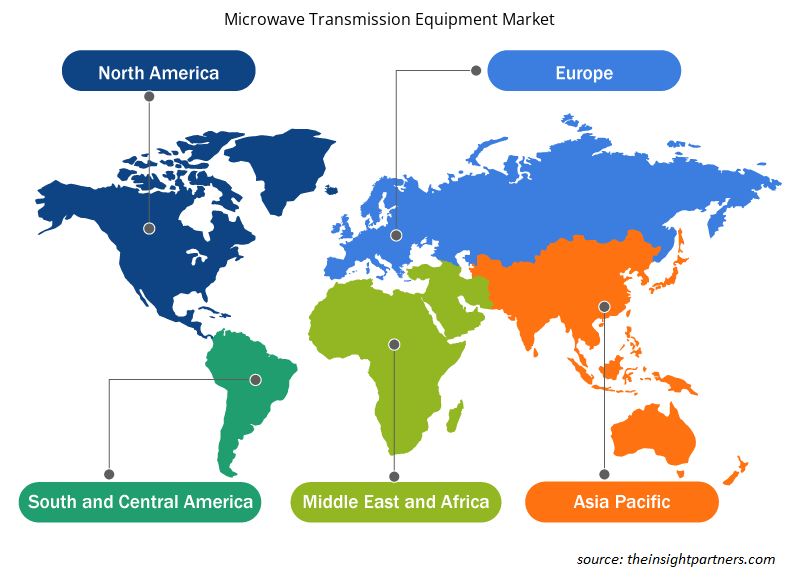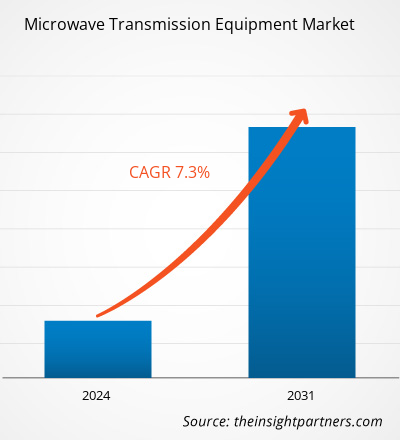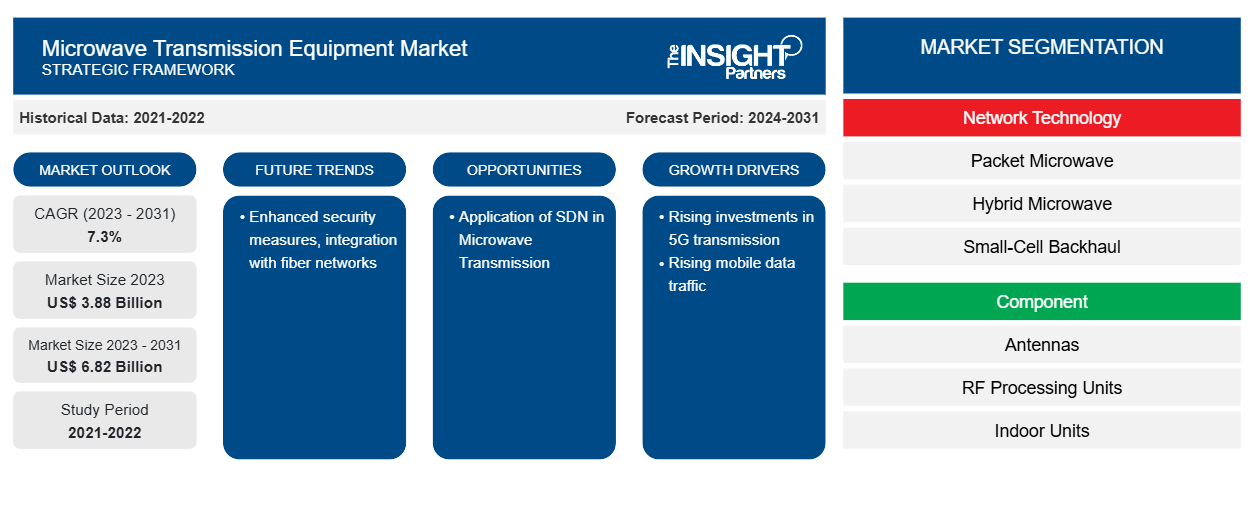Der Markt für Mikrowellenübertragungsgeräte soll von 3,88 Milliarden US-Dollar im Jahr 2023 auf 6,82 Milliarden US-Dollar im Jahr 2031 anwachsen. Der Markt wird zwischen 2023 und 2031 voraussichtlich eine durchschnittliche jährliche Wachstumsrate von 7,3 % verzeichnen. Verbesserte Sicherheitsmaßnahmen und die Integration in Glasfasernetze dürften weiterhin ein wichtiger Trend auf dem Markt bleiben.
Marktanalyse für Mikrowellenübertragungsgeräte
Mikrowellen sind eine drahtlose Sichtverbindungstechnik, die Hochgeschwindigkeitsverbindungen ermöglicht und das Senden und Empfangen von Daten, Videos und Telefonanrufen mithilfe hochfrequenter Radiowellen ermöglicht. Die Funkkommunikation im Weltraum, die Satellitenkommunikation und Punkt-zu-Punkt-Kommunikationssysteme auf der Erde nutzen häufig Mikrowellenfunkübertragung. Radare, Funknavigationssysteme, Sensorsysteme und die Radioastronomie nutzen andere Teile des Mikrowellenfunkbereichs.
Marktübersicht für Mikrowellenübertragungsgeräte
Aufgrund des explosionsartigen Wachstums des mobilen Datenverkehrs, das durch 4G und 5G vorangetrieben wird, sind Dienstanbieter gezwungen, ihre mobile Backhaul-Kapazität mithilfe von Glasfaser-/Kupfer- und drahtlosen Technologien zu erhöhen. Investitionen in die 5G-Infrastruktur gewinnen weltweit an Dynamik. Darüber hinaus nimmt der Datenverkehr zu; dies macht die Entwicklung von Backhaul-Lösungen mit Mikrowellenübertragungsgeräten erforderlich. Dies treibt das Marktwachstum voran.
Passen Sie diesen Bericht Ihren Anforderungen an
Sie erhalten kostenlose Anpassungen an jedem Bericht, einschließlich Teilen dieses Berichts oder einer Analyse auf Länderebene, eines Excel-Datenpakets sowie tolle Angebote und Rabatte für Start-ups und Universitäten.
-
Holen Sie sich die wichtigsten Markttrends aus diesem Bericht.Dieses KOSTENLOSE Beispiel umfasst eine Datenanalyse von Markttrends bis hin zu Schätzungen und Prognosen.
Treiber und Chancen auf dem Markt für Mikrowellenübertragungsgeräte
Steigende Investitionen in 5G-Übertragung begünstigen den Markt
5G soll Nutzern jederzeit und überall Zugriff auf mehr als 100 Mbit/s ermöglichen. Die durchschnittliche und Spitzenbandbreite einer 5G-Basisstation wird zehnmal höher sein als die von 4G-Netzwerken und über 1 Gbit/s bzw. 10 Gbit/s betragen. Die Weiterentwicklung der Mikrowellentechnologien hat zu einem Anstieg der Mikrowellenbandbreite von Mbit/s auf Gbit/s geführt. Die Mikrowellenbandbreite wird 10 Gbit/s ermöglichen, wenn innovativere Technologien eingeführt werden, darunter Multiple-Input Multiple-Output (MIMO), Carrier Aggregation (CA), E-Band mit großer Kapazität und die Kombination von Common-Band mit E-Band. Dies wird den Bandbreitenbedarf für 5G vollständig decken. Weltweit wurden über zwei Millionen Mikrowellengeräte installiert. Im Zeitalter von 5G müssen Mikrowellen das Beste aus ihrer vorhandenen Ausrüstung herausholen, indem sie Teile (wie Platinen und ODUs) nur minimal ersetzen. Dies schützt nicht nur die Anfangsinvestitionen der Betreiber, sondern beschleunigt auch die Entwicklung von 5G.
Anwendung von SDN in der Mikrowellenübertragung
Im Dezember 2021 wurden von Ericsson und Telefónica Deutschland / O2 bedeutende Fortschritte bei der Bereitstellung und Verwaltung von Software-Defined Networking (SDN) für Mikrowellennetze erzielt. Um dem Kommunikationsdienstleister (CSP) die Bereitstellung einer herstellerunabhängigen SDN-Schnittstelle in seinem bundesweiten O2-Netz zu ermöglichen, hat Ericsson sein MINI-LINK-Mikrowellenproduktportfolio im O2-Netz aktiviert. Somit ergeben sich für die Dienstanbieter auf dem Markt Möglichkeiten, die Netzwerkflexibilität und Skalierbarkeit durch den Einsatz von SDN bei der Mikrowellenübertragung zu verbessern.
Segmentierungsanalyse des Marktberichts für Mikrowellenübertragungsgeräte
Wichtige Segmente, die zur Ableitung der Marktanalyse für Mikrowellenübertragungsgeräte beigetragen haben, sind Netzwerktechnologie, Komponenten, Frequenzband, Montageart und Anwendung.
- Basierend auf der Netzwerktechnologie ist der Markt für Mikrowellenübertragungsgeräte in Paketmikrowellen, Hybridmikrowellen, Small-Cell -Backhaul und Zeitmultiplex unterteilt. Das Paketmikrowellensegment hatte im Jahr 2023 den größten Anteil.
- Basierend auf den Komponenten ist der Markt in Antennen, HF-Verarbeitungseinheiten, Inneneinheiten (IDU), Außeneinheiten (ODU) sowie Kabel und Steckverbinder unterteilt.
- Basierend auf dem Frequenzband ist der Markt in L-Band, S-Band, C-Band, X-Band, Ku-Band, Ka-Band, Q-Band und andere unterteilt.
- Basierend auf der Montageart ist der Markt in Full-Indoor-, Split-Mount- und Full-Outdoor-Montage unterteilt.
- Basierend auf der Anwendung ist der Markt in Navigation, Mobilfunk, Funktelekommunikation, Satellitenkommunikation, Radar und Breitbandkommunikation unterteilt.
Marktanteilsanalyse für Mikrowellenübertragungsgeräte nach Geografie
Der geografische Umfang des Marktberichts für Mikrowellenübertragungsgeräte ist hauptsächlich in fünf Regionen unterteilt: Nordamerika, Asien-Pazifik, Europa, Naher Osten und Afrika sowie Süd- und Mittelamerika.
Nordamerika hält im Jahr 2023 einen bedeutenden Anteil am Markt für Mikrowellenübertragungsgeräte. In der Region gibt es eine große Anzahl von 5G-Rollout-Projekten, die die Nachfrage nach Mikrowellenübertragungsgeräten unterstützen. Staatliche Unterstützung und Initiativen in der Region unterstützen die digitale Transformation der Kommunikationsinfrastruktur stark und treiben so das Wachstum des Marktes in der Region voran.
Regionale Einblicke in den Markt für Mikrowellenübertragungsgeräte
Die regionalen Trends und Faktoren, die den Markt für Mikrowellenübertragungsgeräte während des gesamten Prognosezeitraums beeinflussen, wurden von den Analysten von Insight Partners ausführlich erläutert. In diesem Abschnitt werden auch die Marktsegmente und die Geografie von Mikrowellenübertragungsgeräten in Nordamerika, Europa, im asiatisch-pazifischen Raum, im Nahen Osten und Afrika sowie in Süd- und Mittelamerika erörtert.

- Erhalten Sie regionale Daten zum Markt für Mikrowellenübertragungsgeräte
Umfang des Marktberichts über Mikrowellenübertragungsgeräte
| Berichtsattribut | Details |
|---|---|
| Marktgröße im Jahr 2023 | 3,88 Milliarden US-Dollar |
| Marktgröße bis 2031 | 6,82 Milliarden US-Dollar |
| Globale CAGR (2023 - 2031) | 7,3 % |
| Historische Daten | 2021-2022 |
| Prognosezeitraum | 2024–2031 |
| Abgedeckte Segmente |
Von Network Technology
|
| Abgedeckte Regionen und Länder |
Nordamerika
|
| Marktführer und wichtige Unternehmensprofile |
|
Marktteilnehmerdichte für Mikrowellenübertragungsgeräte: Auswirkungen auf die Geschäftsdynamik verstehen
Der Markt für Mikrowellenübertragungsgeräte wächst rasant, angetrieben durch die steigende Nachfrage der Endnutzer aufgrund von Faktoren wie sich entwickelnden Verbraucherpräferenzen, technologischen Fortschritten und einem größeren Bewusstsein für die Vorteile des Produkts. Mit steigender Nachfrage erweitern Unternehmen ihr Angebot, entwickeln Innovationen, um die Bedürfnisse der Verbraucher zu erfüllen, und nutzen neue Trends, was das Marktwachstum weiter ankurbelt.
Die Marktteilnehmerdichte bezieht sich auf die Verteilung der Firmen oder Unternehmen, die in einem bestimmten Markt oder einer bestimmten Branche tätig sind. Sie gibt an, wie viele Wettbewerber (Marktteilnehmer) in einem bestimmten Marktraum im Verhältnis zu seiner Größe oder seinem gesamten Marktwert präsent sind.
Die wichtigsten auf dem Markt für Mikrowellenübertragungsgeräte tätigen Unternehmen sind:
- NEC Corporation
- Huawei Technologies Co., Ltd.
- Telefonaktiebolaget LM Ericsson
- SIAE MICROELETTRONICA-Gruppe
- Intracom Telecom
- Nokia Corporation
Haftungsausschluss : Die oben aufgeführten Unternehmen sind nicht in einer bestimmten Reihenfolge aufgeführt.

- Überblick über die wichtigsten Akteure auf dem Markt für Mikrowellenübertragungsgeräte
Neuigkeiten und aktuelle Entwicklungen zum Markt für Mikrowellenübertragungsgeräte
Der Markt für Mikrowellenübertragungsgeräte wird durch die Erfassung qualitativer und quantitativer Daten nach Primär- und Sekundärforschung bewertet, die wichtige Unternehmensveröffentlichungen, Verbandsdaten und Datenbanken umfasst. Nachfolgend sind einige der Entwicklungen auf dem Markt für Mikrowellenübertragungsgeräte aufgeführt:
- NEC Corporation (NEC; TSE: 6701) gab heute bekannt, dass es eine endgültige Vereinbarung mit Aviat Networks, Inc. (Aviat; Nasdaq: AVNW), dem führenden Experten für drahtlose Transport- und Zugangslösungen, getroffen hat, um sein Wireless Transport Business mit dem von Aviat im Rahmen einer Vermögenskauftransaktion im Wert von 70,0 Millionen US-Dollar in bar und Aktien zu integrieren. (Quelle: NEC Corporation, Pressemitteilung, Mai 2023)
- Huawei hat auf dem Mobile World Congress (MWC) 2023 in Barcelona seine Mikrowellen-Technologie der nächsten Generation MAGICSwave vorgestellt. MAGICSwave nutzt generationsübergreifende Innovationen, um Betreibern beim Aufbau vereinfachter Zielnetze zu helfen, die besser auf die langfristige 5G-Entwicklung ausgerichtet sind, da sie die Gesamtbetriebskosten (TCO) optimieren und die Entwicklung des Transportnetzes reibungslos gestalten. (Quelle: Huawei Technologies Co., Ltd., Pressemitteilung, März 2023)
Marktbericht zu Mikrowellen-Übertragungsgeräten – Umfang und Ergebnisse
Der Bericht „Marktgröße und Prognose für Mikrowellenübertragungsgeräte (2021–2031)“ bietet eine detaillierte Analyse des Marktes, die die folgenden Bereiche abdeckt:
- Marktgröße und Prognose für Mikrowellenübertragungsgeräte auf globaler, regionaler und Länderebene für alle wichtigen Marktsegmente, die im Rahmen des Berichts abgedeckt sind
- Markttrends für Mikrowellenübertragungsgeräte sowie Marktdynamik wie Treiber, Einschränkungen und wichtige Chancen
- Detaillierte PEST/Porters Five Forces- und SWOT-Analyse
- Marktanalyse für Mikrowellenübertragungsgeräte, die wichtige Markttrends, globale und regionale Rahmenbedingungen, wichtige Akteure, Vorschriften und aktuelle Marktentwicklungen umfasst
- Branchenlandschaft und Wettbewerbsanalyse, die die Marktkonzentration, Heatmap-Analyse, prominente Akteure und aktuelle Entwicklungen auf dem Markt für Mikrowellenübertragungsgeräte umfasst
- Detaillierte Firmenprofile
- Historische Analyse (2 Jahre), Basisjahr, Prognose (7 Jahre) mit CAGR
- PEST- und SWOT-Analyse
- Marktgröße Wert/Volumen – Global, Regional, Land
- Branchen- und Wettbewerbslandschaft
- Excel-Datensatz
Aktuelle Berichte
Erfahrungsberichte
Grund zum Kauf
- Fundierte Entscheidungsfindung
- Marktdynamik verstehen
- Wettbewerbsanalyse
- Kundeneinblicke
- Marktprognosen
- Risikominimierung
- Strategische Planung
- Investitionsbegründung
- Identifizierung neuer Märkte
- Verbesserung von Marketingstrategien
- Steigerung der Betriebseffizienz
- Anpassung an regulatorische Trends























 Kostenlose Probe anfordern für - Markt für Mikrowellenübertragungsgeräte
Kostenlose Probe anfordern für - Markt für Mikrowellenübertragungsgeräte